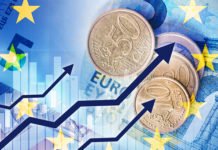Personal income rose 0.4% in June, right on market expectations and matching the prior month’s gain. Adjusted for inflation and removing taxes, real disposable income was up 0.3% in the month.
Personal spending rose 0.4% in nominal terms, bang on market expectations. Spending in real terms rose 0.3%, driven mostly by services (+0.4%), with particular strength seen in food services and accommodations. Real goods spending was buoyed by durables (+0.4%) but held back by non-durables (-0.1%), resulting in a near-flat print.
Both, the headline and core PCE deflators rose 0.1% in June, in line with market consensus. A boost from food prices (0.2%) was partially offset by lower energy costs(-0.1%). Year-over-year gains held roughly steady for both, but came in a touch below expectations. Revisions to the data indicate that the Fed’s preferred measure of inflation hit its target earlier in March, and has held near target at 1.9% since then.
Personal income and spending data were subject to revisions as part of the GDP benchmark revisions last Friday. The most notable change was that to the personal savings rate was revised up significantly. The May figure for instance, was revised up to 6.8% from 3.2% – over double the prior reading. The upward revision was the result of higher income growth as more complete data sources resulted in upward revisions to proprietors’ income, dividend income and wages & salaries. In June, the personal savings rate held steady at 6.8% after three consecutive monthly declines.
Key Implications
Last week’s GDP report had already revealed a 4% (annualized) gain in second-quarter consumption, so today’s data held few surprises. But, the data is still useful in gauging near-term activity, with a respectable outturn in June providing a decent handoff to third quarter spending. In addition, it’s worth remembering that the second-quarter reflects a rebound from a very soft start to the year, with a similar performance unlikely to be repeated in the second half of 2018. We expect spending to settle back toward a more sustainable pace of around 2½ percent ahead – a path also supported by still-decent income gains.
The results from today’s report must also be considered alongside numerous revisions to the data, the most striking of these being that to the personal savings rate, which is now over double that of prior estimates. The upgrade, which points to the rate being closer to that of the mid-1990s, rather than near the trough of the mid-2000s, helps ease some of the concerns that Americans had been excessively dipping into their piggy banks to sustain their spending habits.
More cushion than previously-thought in the forms of savings, a decent consumption pace and the Fed’s preferred inflation measure holding near the target, are all elements consistent with a continuation of the tightening cycle. But, given that core PCE is still slightly below target, the Fed should be in no rush to raise rates, leaving September as the most likely time for the next trigger pull.













